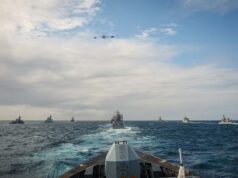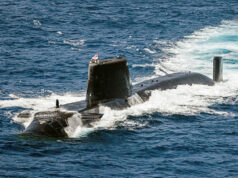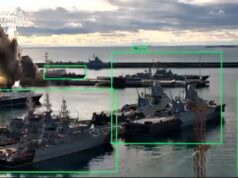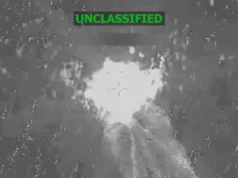Ships from Canada, France, Germany, Italy, the Netherlands, Spain, the United States and the United Kingdom are engaged in a live-fire integrated missile defence exercise off the Scottish coast.
Lasting a month, Exercise Formidable Shield will see a Royal Navy Type 45 Destroyer and two Type 23 Frigates join one of the most sophisticated and complex air and missile exercises ever undertaken in the UK.
The vessels will work together to detect, track and shoot down both anti-ship and ballistic missile targets. 13 ships will fire on 12 live missile targets over four days, improving how allies work together in an air and missile defence environment.
Defence Secretary Sir Michael Fallon said:
“North Korean tests have shown the danger of rogue states developing longer range missiles. By hosting this cutting-edge exercise in anti-missile defence with allied navies Britain is at the forefront of developing a more effective response to this growing threat.”
Rear Admiral Paul Bennett, Assistant Chief of Naval Staff (Capability) said the exercise was an excellent showcase for the UK’s defensive capabilities. He commented:
“Formidable Shield is a terrific example of the leading role that the UK plays in development of maritime air and missile defence – protecting our people and working with our allies.”
During the scenario, Canadian frigate HMCS Montreal fired Evolved Sea Sparrow Missiles (ESSM) and the USS Mitscher fired Standard Missiles-2 at the incoming Mirach and Firejet anti-ship cruise missiles as part of a no-notice launch of anti-ship cruise missiles in the IAMD exercise scenario.

The Mirach and Firejet missiles were launched from the Hebrides Range located on the Western Isles of Scotland.
Rear Adm. Francesco Covella, Italian Navy, STRIKFORNATO Deputy Chief of Staff of Operations said:
“This exercise provides the opportunity to use portions of NATO BMD architecture and develop potential tactics, techniques and procedures in the NATO operations. STRIKFORNATO is, since 2016, the organization responsible for control of NATO Maritime Ballistic Missile Defense forces; Formidable Shield is the ideal opportunity to exercise those capabilities at sea, for the first time, with a NATO IAMD task group.
This exercise is a prime example of NATO strength and demonstrates the commitment of NATO allies to the security of Europe.”
Simultaneously, ships from the UK, France, Italy and Spain tracked a short-range ballistic-missile target that was also fired from the Hebrides Range during a simulated engagement, conducting all steps of a routine engagement.














I really think we need a BMD system ourselves – probably in concert with France and Italy.
It seems ridiculous that we can track an incoming BM, have the technology and the budget to deal with it but not the will or application.
Agree.
But unless spending is raised what part of conventional forces gets the chop to pay for it?
Can the Type 45 with Sea Viper/Sampson do BMD?
Last week at the Sea Power 2017 Conference in Sydney as part of the Pacific 2017 International Maritime Exhibition the Australian PM announced that the Aegis combat management system (Baseline 9) would be mandated for RANs nine future frigates.
The Australian CEAFAR phased array radar, already fitted to the current ANZAC frigates, would be integrated with the Aegis combat system alongside an interface based on the in-service SAAB 9LV system to integrate unique Australian systems including Nulka decoys.
An upgrade of the Aegis system from baseline 8 to baseline 9 was also foreshadowed (baseline 8 was the latest version available when the AWD design was frozen for production).
In practice this means that the RAN will have 12 Aegis equipped ships with an anti-ballistic missile capability from the early 2020s. This capability will employ SM3 (and potentially SM6) missiles already proven in USN service.
The ships will also provide a collaborative engagement capability (CEC) that will allow targeting data from Link 16 equipped and other networked platforms (RAAF Wedgetail, FA18, F35, P8 etc) to be passed on to RAN ships and be fully integrated in coalition with USN Arleigh Burkes etc. plus most likely other Pacific region navies with Aegis (Japan and South Korea).
This announcement is also likely to strengthen the Navantia bid for the RANs future frigate program, given they are the only one of three contending consortia to have experience with integrating the Aegis system.
http://www.theaustralian.com.au/national-affairs/missile-defence-for-australias-future-frigates-against-rogue-states/news-story/9a7cdda6bd7c9ffa943a6d67342f0a97
https://www.minister.defence.gov.au/minister/marise-payne/media-releases/joint-media-release-new-approach-naval-combat-systems
This approach was foreshadowed in a recent APSI think tank article:
https://www.aspistrategist.org.au/the-heart-of-the-matter-choosing-a-combat-management-system-for-the-future-frigates/
Hello i’m saanouni Mahmoud electrical engineer
Looking for an opportunity to work with you
Last week at the Sea Power 2017 Conference in Sydney as part of the Pacific 2017 International Maritime Exhibition the Australian PM announced that the Aegis combat management system (Baseline 9) would be mandated for RANs nine future frigates.
The Australian CEAFAR phased array radar, already fitted to the current ANZAC frigates, would be integrated with the Aegis combat system alongside an interface based on the in-service SAAB 9LV system to integrate unique Australian systems including Nulka decoys.
An upgrade of the Aegis system from baseline 8 to baseline 9 was also foreshadowed (baseline 8 was the latest version available when the AWD design was frozen for production).
In practice this means that the RAN will have 12 Aegis equipped ships with an anti-ballistic missile capability from the early 2020s. This capability will employ SM3 (and potentially SM6) missiles already proven in USN service.
The ships will also provide a collaborative engagement capability (CEC) that will allow targeting data from Link 16 equipped and other networked platforms (RAAF Wedgetail, FA18, F35, P8 etc) to be passed on to RAN ships and be fully integrated in coalition with USN Arleigh Burkes etc. plus most likely other Pacific region navies with Aegis (Japan and South Korea).
This announcement is also likely to strengthen the Navantia bid for the RANs future frigate program, given they are the only one of three contending consortia to have experience with integrating the Aegis system.
Very articulate.
Oh FFS PLEASE change the record!
Stating the obvious again on a completely unrelated article. Typical idiot TH.
There were cuts in 1991, and 1995, and 1998, and 2004, and 2009, and all the time in between, and 2010, and 2015, and now. And the UK is STILL a major power, to your disgust.
Sorry old boy.